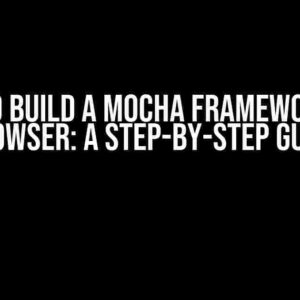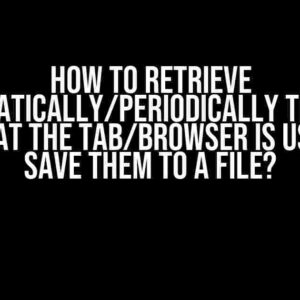Are you tired of dealing with the uncertainty of a WebView’s loading status? Do you find yourself constantly checking if the page has finished loading before interacting with it? Fear not, dear developer, for we’ve got you covered! In this article, we’ll delve into the world of WebView interaction, exploring the ways to handle the seemingly daunting task of interacting with a WebView when it may or may not be loaded.
Understanding the WebView’s Loading Cycle
Before we dive into the nitty-gritty of interacting with a WebView, let’s first understand the loading cycle of a WebView. A WebView goes through several stages during its loading process:
-
Loading Started: The WebView begins loading a new URL or HTML content.
-
Page Loading: The WebView renders the page, including loading resources such as images, CSS, and JavaScript.
-
Page Finished: The WebView finishes loading the page, and all resources have been successfully loaded.
-
Page Failure: The WebView encounters an error while loading the page, such as a network failure or a script error.
The Problem: Interacting with a WebView When It’s Not Loaded
Now that we understand the loading cycle, let’s address the elephant in the room: what happens when we try to interact with a WebView that’s not yet loaded? Well, it’s not pretty. You might encounter:
-
Unexpected behavior or crashes
-
-
Inconsistent results or errors
To avoid these issues, we need to ensure that we interact with the WebView only when it’s fully loaded and ready for action.
Solutions for Interacting with a Loaded WebView
Now that we’ve identified the problem, let’s explore the solutions! Here are some ways to interact with a WebView when it may or may not be loaded:
1. Using the WebViewClient Class
The WebViewClient class provides a way to receive notifications about the WebView’s loading status. By overriding the onPageFinished method, we can execute code only when the page has finished loading:
webView.setWebViewClient(new WebViewClient() {
@Override
public void onPageFinished(WebView view, String url) {
// Interact with the WebView here
}
});2. Listening for the onPageFinished Event
If you’re using a framework or library that provides an event-driven approach, you can listen for the onPageFinished event and execute code when the WebView has finished loading:
webView.addEventListener('pagefinished', () => {
// Interact with the WebView here
});3. Checking the WebView’s Loading Status
In some cases, you might need to check the WebView’s loading status programmatically. You can do this by using the getProgress() method, which returns the WebView’s loading progress (0-100):
int progress = webView.getProgress();
if (progress == 100) {
// Interact with the WebView here
}4. Using a Timeout or Delay
As a last resort, you can use a timeout or delay to wait for the WebView to finish loading. This approach is not recommended, as it can lead to inconsistent results, but it can be useful in certain scenarios:
setTimeout(() => {
// Interact with the WebView here
}, 2000); // Wait for 2 secondsBest Practices for Interacting with a WebView
To ensure a smooth and reliable interaction with a WebView, follow these best practices:
| Best Practice | Description |
|---|---|
| Check the WebView’s loading status | Verify that the WebView has finished loading before interacting with it. |
Use the WebViewClient class |
Override the onPageFinished method to execute code when the page has finished loading. |
| Avoid interacting with the WebView during loading | Wait for the WebView to finish loading before executing code that interacts with it. |
| Handle errors and exceptions | Be prepared to handle errors and exceptions that may occur during WebView interaction. |
Conclusion
Interacting with a WebView when it may or may not be loaded can be a daunting task, but with the right strategies and best practices, you can ensure a smooth and reliable experience for your users. By understanding the WebView’s loading cycle, using the WebViewClient class, listening for events, checking the loading status, and following best practices, you’ll be well on your way to mastering WebView interaction.
Remember, a well-behaved WebView is a happy WebView! So, go forth and interact with those WebViews like a pro!
Here is the FAQ section about “Interacting with a webview when it may or may not be loaded” in a creative voice and tone:
Frequently Asked Question
Get ready to dive into the world of webviews and learn how to handle those pesky loading issues!
How can I wait for a webview to load before interacting with it?
The age-old question! You can use the `WebViewClient` class and override the `onPageFinished` method to receive a callback when the page has finished loading. This is usually the safest way to ensure the webview is fully loaded before you start interacting with it.
What if I need to perform an action as soon as the webview is loaded, but the page loading might fail?
In this case, you can use a combination of `onPageFinished` and `onReceivedError` callbacks. If the page loading fails, `onReceivedError` will be called, and you can handle the error accordingly. If the page loads successfully, `onPageFinished` will be called, and you can perform your desired action.
Can I use a timeout to wait for the webview to load?
While it’s technically possible to use a timeout, we wouldn’t recommend it. Web pages can take varying amounts of time to load, and a hardcoded timeout might not work in all scenarios. Instead, rely on the `onPageFinished` callback to ensure the webview is fully loaded before interacting with it.
How do I handle situations where the webview might not be loaded at all?
To handle cases where the webview might not be loaded, you can check the `WebView.getProgress()` method, which returns the loading progress of the web page. If the progress is 0 or the `WebView.getUrl()` returns null, it’s likely the webview hasn’t loaded yet.
Are there any best practices for interacting with a webview when it may or may not be loaded?
Absolutely! Always prioritize using callbacks like `onPageFinished` and `onReceivedError` to ensure the webview is loaded and ready for interaction. Be prepared to handle errors and edge cases, and avoid using timeouts or hardcoded assumptions about the loading process.
I hope this helps! Let me know if you need anything else.



